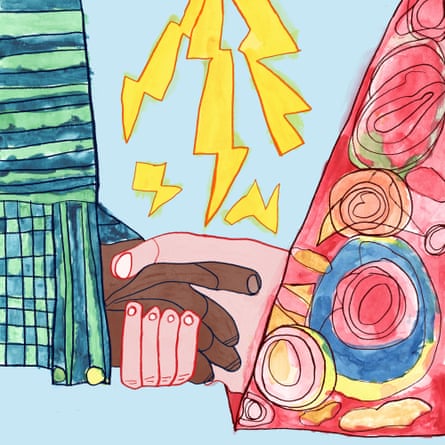
For most of his years as an actor and theatre-maker, Adam Welsh did not know he had attention-deficit hyperactivity disorder. Neither did his agent, nor anyone he worked with. But since being diagnosed at the age of 34, he has realised the impact ADHD had on his career.
“I just found myself repeatedly in situations where employers wanted to let me go because of my behaviour,” he says.
Last year Welsh launched Divergent Talent, an agency representing neurodivergent (ND) actors, writers and creatives, and securing the adjustments they need to work successfully in the entertainment industry – from schedules that are long enough, to spaces where they can de-stress on hectic sets.
The reaction from potential clients was overwhelming. “We put out one tweet and the response was enormous,” says Welsh. “And it doesn’t ever really stop.”
Q&A
What is neurodiversity?
Show
Neurodivergent is an umbrella term for people whose brains work differently to those of people considered “neurotypical”, and includes conditions such as autism, ADHD, dyslexia, dyspraxia (which affects physical coordination), dyscalculia (difficulty in understanding numbers) and Tourette syndrome. It is common for neurodivergent people to have coexisting conditions.
The concepts of neurodivergence and neurodiversity recognise that such conditions bring particular strengths as well as challenges, rather than simply characterising them as disorders. For instance, while dyslexic people may struggle with literacy, they often excel at 3D visual thinking and have strong verbal skills.
About 15% to 20% of the population is thought to be neurodivergent, but diagnoses for some conditions have increased significantly in recent years, including among adults. A report in March by the US Centers for Disease Control and Prevention on prevalence of autism among children found that one in 36 eight-year-olds is autistic. The figure reported in 2021 was one in 44, and in 2006 it was just one in 110.
Last month research from University College London showed that in the UK both ADHD diagnoses and prescriptions for ADHD medication rose significantly over the past two decades – except for children under five – with the relative increase largest in adults.
Among men aged 18 to 29, diagnoses increased approximately twenty-fold in that period, while prescriptions were up by a factor of more than 50 (from 0.01% to 0.56%). The researchers said although they did not know exactly why this was happening, it could be because ADHD has become better recognised and diagnosed.
Was this helpful?Thank you for your feedback.
A decade after programmes to recruit neurodiverse talent – often focused on autism – were first launched by blue-chip companies such as IBM, the business software firm SAP, and the law and tax consultancy EY, Welsh is part of a growing movement to highlight the skills that a wider range of neurological differences, including ADHD, dyspraxia and dyslexia, bring to workforces of all kinds.
In a recent study by Birkbeck, University of London’s Centre for Neurodiversity at Work, employers highlighted hyperfocus, creativity, innovative thinking, visual reasoning, and strength in processing detail and recognising patterns as valued qualities of ND staff.
It’s very common for autistic people to be brilliant communicators – very clear, and they say what they meanDanielle Gleicher-Bates
Yet the widespread reliance on traditional interview techniques – where body language and eye contact count for so much – and rigid expectations in areas such as organisation and time management, mean barriers to work remain high for many neurodivergent people.
According to the University of Connecticut’s Center for Neurodiversity and Employment Innovation, unemployment rates among neurodivergent adults are still as high as 30-40%. It is thought that people with neurodivergence make up 15-20% of the population.
“I’m ADHD, autistic, dyslexic, dyspraxic and have a visual-processing disorder,” says Danielle Gleicher-Bates, who is studying to be a barrister and is a member of the organisation Neurodiversity in Law, which works to support and destigmatise the conditions within the legal profession.
Those characteristics give her some distinct advantages in a law career, she says, from an aptitude for problem-solving and strategising to a talent for advocacy born of having to do it for herself all her life.
She adds that stereotypes, such as the idea that autistic people always struggle socially, are deeply unhelpful. “Actually, it’s very common for autistic people to be brilliant communicators: very clear, and they say what they mean, which is vital for law,” she says.
Yet pervasive stigma and discrimination – often based on the misconception that neurodivergence equals lower intelligence – mean ND lawyers often feel they cannot be open about who they are. “Neurodivergent people are in the profession,” Gleicher-Bates says. “But they’re being made [to feel] invisible.”
 View image in fullscreenThe spark of creativity can emerge when neurodivergent minds meet. Illustration: Clifton Wright/The Guardian
View image in fullscreenThe spark of creativity can emerge when neurodivergent minds meet. Illustration: Clifton Wright/The Guardian
Signs from the industry have been promising. Since it was founded in 2020, Neurodiversity in Law has seen a significant increase in the number of law firms and chambers requesting reviews of their recruitment practices to make them more neuroinclusive.
Should the kind of special recruitment programmes seen in sectors such as tech, software and professional services be extended to other industries? For Nancy Doyle, a professor of business psychology and the Centre for Neurodiversity at Work’s co-director, the answer is a clear no.
Though groundbreaking in their early days, “the affirmative-action programmes have run their course,” she says. Doyle, an “ADHD-er” as she calls it, is concerned about access. If participants need a diagnosis, this often entails a lengthy wait for statutory services or high private fees, and she says that having to disclose a diagnosis to be hired may be stigmatising.
The next step – especially in the context of rising numbers of diagnoses – is to fix the “broken” recruitment processes that have been shown to put talented would-be employees at a disadvantage. This could be by making adjustments such as offering alternatives to interviews, adopting flexitime, or allowing recruits to wear noise-cancelling headphones in an open-plan office available to everyone.
Offering options such as individual coaching for memory, organisation and time-planning to small groups instead, she suggests, would also benefit new managers, staff in perimenopause and those living with chronic illness.
Within industries such as advertising and marketing, neurominorities are thought to be relatively well represented, thanks to their reputation for having high levels of innovation and creativity.
skip past newsletter promotion
Sign up to Global Dispatch
Free newsletter
Get a different world view with a roundup of the best news, features and pictures, curated by our global development team
Enter your email address Enter your email address Sign upPrivacy Notice: Newsletters may contain info about charities, online ads, and content funded by outside parties. For more information see our Privacy Policy. We use Google reCaptcha to protect our website and the Google Privacy Policy and Terms of Service apply.
after newsletter promotion
Things like icebreakers and team-building exercises can actually cause harm to neurodivergent people. People do tend to hire extrovertsLucy Hobbs
Yet there is still much to be done to empower them, says Lucy Hobbs, an art director, copywriter and founder of The Future is ND, which aims to help neurodiverse people “turn up as themselves and thrive”. When Universal Music surveyed employers in the creative industries, 77% said adapting to be more neuroinclusive was not a priority over the next year.
Though the flexibility of work in adland can be a positive for ND people, it can also be a tough environment, according to Hobbs. “Things like icebreakers and team-building exercises can actually cause harm to neurodivergent people,” she says.
“People do tend to hire extroverts – those people that can do the socialising,” Hobbs adds. Like Doyle, she does not want special entry schemes, but universal design, with a “menu” of adjustments available to everyone.
What’s next for those who pioneered neurodivergent-specific recruitment programmes? Hiren Shukla, founder of EY Global’s Neuro-Diverse Centres of Excellence (NCoEs), says the business is now applying the principles to other groups of people who may face barriers in a traditional recruitment process.
“We’ve pivoted from neurodiversity to neuroinclusion, and that is a stepping stone towards universal design and application of processes,” he says.
The first NCoE was launched in Philadelphia in 2016; today they operate in 19 cities across eight countries around the world, including Canada, India, Poland and the UK. Recruitment is via a performance-based process, rather than behaviour-based interviews, and applicants do not need a diagnosis.
Having more inclusive teams has in turn led to more inclusive leaders, he adds. “It’s given us a training ground to train everybody else.”
Autism in India: how a pioneering jobs scheme is opening up opportunitiesRead more
It has been a personal journey of discovery as well as a business one: Shukla, who describes his introduction to the topic of neurodiversity several years ago as striking a “visceral nerve”, was recently diagnosed with ADHD himself.
Today Welsh has 30 clients on his books, including Dani Arlington, Jodie Comer’s understudy in Prima Facie on Broadway, who earned a standing ovation last month after stepping in when breathing difficulties forced the Killing Eve star to leave the stage. Soon he will launch a new digital division for content creators and later this year will partner with the Young Vic on a development scheme for ND artists.
Sometimes he manages to attach an access-support worker to a client, paid for through the government’s Access to Work scheme or on the production payroll. Even better, and becoming more common, is when productions employ an access coordinator.
As awareness of the needs – and talent – of ND performers grows, there is more to celebrate. “When a support worker gets attached to a job – for me, that’s as big as somebody doing a Disney movie,” Welsh says.

